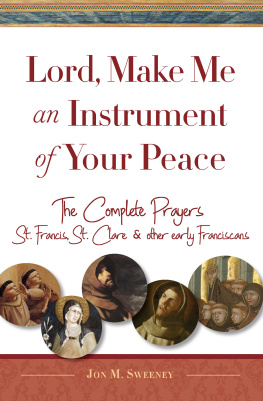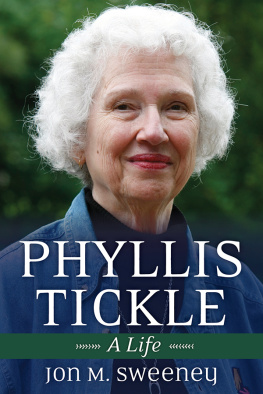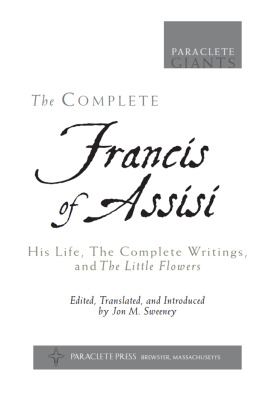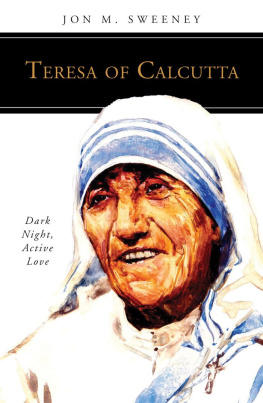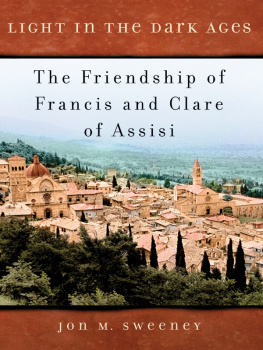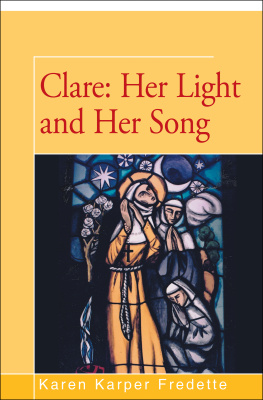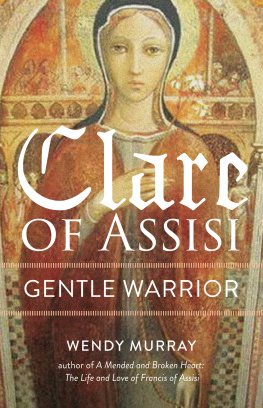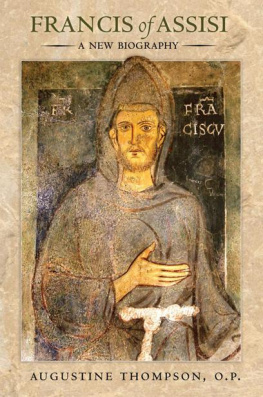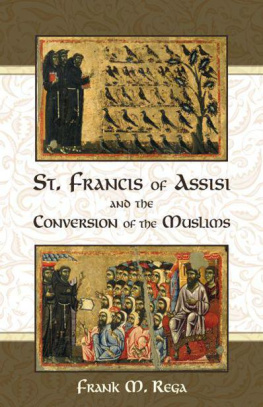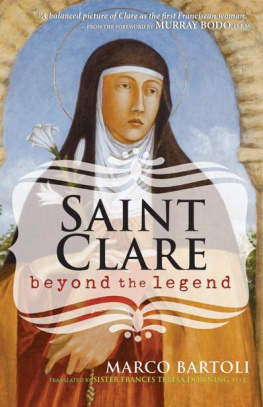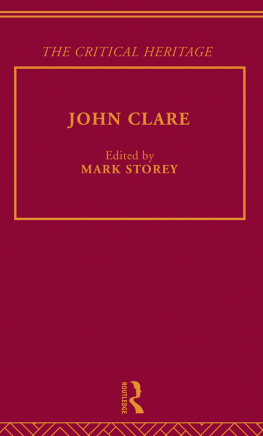PRAISE FOR JON M. SWEENEYS BOOKS...
In Sweeneys hands, the story of a man often dismissed as nave and incompetent becomes an engaging mystery and an enjoyable primer on the ecclesiastical wheeling and dealing of the late Middle Ages.
Paul Moses, America magazine
Sweeney achieves a fine balance between excellent scholarship and sweet accessibility for every average reader.
Walter Wangerin, Jr., author of St. Julian and
The Book of God
Sweeney, in very accessible concepts and language, presents a marvelously contemporary and inclusive theology of sanctity and saints.
Catholic Library World
A rich resource of information, insights and beauty.... Both critical and reverential.
Bishop Frederick Borsch,
Professor of New Testament and Chair of Anglican Studies, Lutheran Theological Seminary
Sweeney examines his story and its meaning with unusual humility. His tone is thankful and affirming, meant to shore up bridges rather than burn them down.
Betty Smartt Carter, Books & Culture
Jon Sweeney is a fine, informative writer. He has a way of discussing a variety of religious matters in clear, common sense terms.... Highly recommended.
Church and Synagogue Library Association
FRANCIS
AND
CLARE

The Holy Conversation of Saints Francis and Clare
FRANCIS
AND
CLARE
A True Story
Jon M. Sweeney

2013 First Printing This Edition
2007 First Printing Original Edition
Francis and Clare: A True Story
Copyright 2007 by Jon M. Sweeney
ISBN: 978-1-61261-454-0
Except for quotations from the New Testament Gospels, Scripture quotations are taken from the New Revised Standard Version Bible, copyright 1989 by the Division of Christian Education of the National Council of the Churches of Christ in the United States of America, and are used by permission. All rights reserved.
Quotations from the New Testament Gospels are taken from The New Jerusalem Bible, published and copyright 1985 by Darton, Longman & Todd Ltd. and Doubleday, a division of Random House Inc., and are used by permission of the publishers.
The Paraclete Press name and logo (dove on cross) are trademarks of Paraclete Press, Inc.
The Library of Congress has catalogued the first edition of this book as follows:
Sweeney, Jon M., 1967
Light in the dark ages : the friendship of Francis and Clare of Assisi / by Jon M. Sweeney.
p. cm.
Includes bibliographical references and index.
ISBN 978-1-55725-476-4
1. Francis, of Assisi, Saint, 1182-1226. 2. Clare, of Assisi, Saint, 1194-1253.
3. Christian saints--Italy--Assisi--Biography. I. Title.
BX4700.F6S93 2007
271.302--dc22
10 9 8 7 6 5 4 3 2 1
All rights reserved. No portion of this book may be reproduced, stored in an electronic retrieval system, or transmitted in any form or by any meanselectronic, mechanical, photocopying, recording, or any otherexcept for brief quotations in printed reviews, without the prior written permission of the publisher.
Published by Paraclete Press
Brewster, Massachusetts
www.paracletepress.com
Printed in the United States of America
FOR CHRISTINA
with respect and affection
OTHER BOOKS BY JON M. SWEENEY
The Road to Assisi (edited)
The St. Francis Prayer Book
The St. Clare Prayer Book
The Little Flowers of Saint Francis (edited and translated)
Francis of Assisi in His Own Words (edited and translated)
LIST OF ILLUSTRATIONS
All of the other illustrations are reproductions of Giotto,
or School of Giotto, frescoes from Assisi, Padua, and Florence.
CONTENTS
APPENDIX
Chronology and Calendar of Important Remembrances


BEGINNINGS
Wrapped in the colorful silks imported and sold by Peter Bernardone, most of the highborn girls in Assisi paid close attention to matters of courtship, honor, and family. Seasonal events in the cathedral church and the governors estate occupied their minds, and their hearts were wooed by the songs of young would-be troubadours carousing in the streets below their bedroom windows after dark. Francis Bernardone was once one of those young men. But by all accounts, Clare Favorone was never one of those girls.
Francis and Clare were both children of Assisi, Italy, where being baptized into the Church was once the equivalent of citizenship. They came from what we would call upper-middleclass families. Clare was a young teenager when Francis began his slow process of conversion. She was about fifteen and he was twenty-seven when she first heard him preach about poverty and joy at the San Rufinus cathedral. Her family home bordered the great church, and she was accustomed to regularly attending services there. Hearing Francis preach probably stirred the beginnings of conversion. Feeling Gods presence wouldnt have frightened her, for she was never easily frightened. Only two years later, Clare began her own rejection of vanity, self-interest, and wealth. She quietly renounced worldly affairs in March 1212 and became the first woman to join Francis and his friars. These were simple gestures, but they were nevertheless recognized by Clares contemporaries as the first marks of an independent woman.
The life of Francis is well-known, but Clares less so. Her first biographer tells us that she secretly wore hair shirtsrough garments of asceticism and penancefrom an early age, and while we may not take such a description as absolute fact, the point is that Clare was different. She didnt pine for the latest fabrics and dyes that Peter Bernardone brought back with him from his trips to France. She wasnt looking anxiously for her future husband or counting the days until her wedding. From an early age, she seemed to others to be out of step with the expectations of a fortunate girl from a promising family.
Within four and one-half years of Clares conversion, we have evidence from a letter written by Jacques of Vitry, who was elected the bishop of Acre in 1216 and traveled to Perugia upon the death of Pope Innocent III, that there were many vibrant communities of friars and sisters throughout Italy. Disappointed with the heresy and worldliness that he discovered during his travels in Italy, the Frenchman described the early Franciscans this way, as he discovered them for the first time:
Many well-to-do secular people of both sexes, having left all things for Christ, had fled the world. They were called Lesser Brothers and Lesser Sisters.... They are in no way occupied with temporal things, but with fervent desire and ardent zeal they labor each day to draw from the vanities
And so it was. The Franciscan movement began in simple ways, with bold but modest intentions, and grew rapidly. The Franciscans presumed to live like Jesus. Francis, Clare, and their early followers were part of a select group of Christians through the ages who have been passionately spiritual and ardently practical at the same time. In the long history of faith, spiritual vitality has flowed best when humans have rediscovered Jesus and tried to replicate his life in their own. Moral and practical decisions have been infused with spiritual vitality in those eras when the words of Jesus were followed most closely.
Next page

